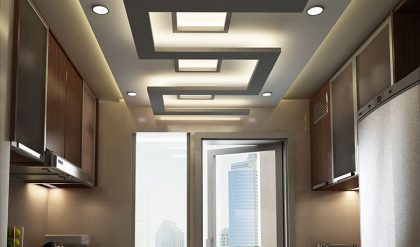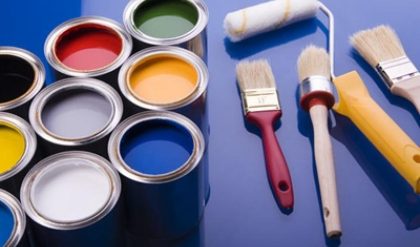Nitrocellulose Lacquers (Non-convertible)
Nitrocellulose is produced by the action of nitric acid and sulphuric acid in a form of cellulose such as wood pulp. It is highly explosive and dampers are added. The volatile material will be 70 to 80 % of total, consisting of about seven different hydrocarbons. It forms a non-convertible rapid drying paint suited to such application as motor car spraying.
Vinyl Lacquers (Non-convertible)
These are based on binder of a copolymer of vinyl acetate and vinyl chloride. A copolymer is one made up from two different types of molecules in the polymer chain. In this case, vinyl acetate and vinyl chloride is as shown below. The solvent may consist of a mixture such as methyl ethyl ketone, methyl isobutyl ketone, cyclol-exanon and toluene in suitable proportions.
Acrylic Lacquers (Non-convertible)
Thermoplastic acrylic resins are the polymerization products of methacrylates or alkyl acrylates. The use of butyl Acrylate increases colour retention but decreases hardness.
Chlorinated Rubber (Non-convertible)
Produced by treating rubber with chlorine to produce a creamy white powder for use as a binder. The solvents as in the previous three consists of suitable hydrocarbons. The main advantage of this type of paint is its chemical resistance which is gained at the expense of appearance.
Oil Bound Paints (Convertible)
Until the beginning of the century nearly all paints consisted of while lead dispersed in linseed oil. In fact all natural oils of both animal and vegetable origin are tri-series of glycerol.
There are fatty acids with a molecular chain containing mist commonly eighteen carbon atoms.
The process of hardening is firstly evaporation of the volatile solvent followed by polymerization of the fatty acid and molecules after the addition of oxygen. The resulting polymer is different from the original oil and is not soluble in the solvent so that there are no problems when brushing on later coats. Evaporation of the thinner does limit the thickness of coat that can be applied. They need a very long drying time.
Alkyd Resins (convertible)
There are again based on the linseed oil but contain a polymeric ester as a result of the reaction between glycerol and phthalic anhydride. They need a shorter drying time. Three main types are used:
- Long oil alkyds with more than 60% oil
- Short-oil alkyds with less than 40% oil
- The non-drying variety that are used with nitrocellulose resins. The thixotropic alkyds are produced from the same raw materials but modified by reaction with small quantities of polyamide resin.
Epoxy Esters of Fatty Acids (convertible)
These are produced by reacting epoxy resins with fatty acids and give greater water and chemical resistance than normal oil based paints. Linseed esters are used as boat varnishes because of their greater water resistance.
Two Can Paints (convertible)
There are several different types containing a base and hardener. The main advantage comes because a solvent is not needed for some of them which at least in theory remover the thickness limitation. Two serious difficulties exists. The first comes from the fact that once the base and hardener are mixed, the reaction begins and after the start of gelation in about 30 minutes the paint is useless if it has not been applied. The second arises if a further coat is applied before the first has completely finished the hardening process. If later coats are put too soon, damage will be done to earlier ones.
Emulsion Paints (Convertible)
The resin consists of a latex similar to rubber. It is insoluble in water which is present to the extent of about 30%. A typical latex is polyvinyl acetate and the pigments might be titanium dioxide. The emulsifiers are incompatible with resins which result in low gloss paints.
Enamel Paints
Enamels consists of high grade bases like zinc oxide or lead oxide ground in oil or varnish. They dry slowly leaving a hard tough and elastic film which is smooth and durable. Enamel painted surfaces are washable and are not affected by acids, alkalies, grease or steam.
These can be made in any tint, however delicate. Even though they are more costly than ordinary paints, yet because of their durability they ultimately prove to be more economical. They are equally good for both external and internal works.
Enamel made from synthetic resins, known as synthetic enamel dries quickly and is more durable.
Lacquer
It is a solution of natural or synthetic resin in a volatile solvent. It is obtained by dissolving resin and film forming nitro cellulose or shellac in a solvent. Nitrocellulose is obtained by the action of a mixture of sulphuric and nitric acid on cellulose derived from wood or cotton fibre.
Solvent used in a mixture of ketone alcohol hydrocarbon and the plasticizer. The solvent evaporates easily.
Fire Proof Paints:
Fire resisting solution coating of sodium tungstate and asbestos paints retard the action of fire. As such wherever timber work is introduced to e fire resistance, it may be coated with either of these solutions.
Cellulose Paints:
Natural cellulose is chemical treated and converted to nitrate or acetate or to methyl of ethyl cellulose. The resultant derivative of cellulose is dissolved in petroleum or in coaltar hydrocarbon. Plasticiser which is an organic compound of low volatility is added to cellulose paints to improve adherence, toughness, smoothness and elasticity of the paint film. Compared with ordinary oil paints, this paint can be easily washed, cleaned as it has greater hardness, elasticity and smoothness and withstand temperature changes and hot water better.
It produces more glossy and durable decorative coat than oil paints with metallic oxide bases. Compared with oil paints, it costs more. Spray paint or duce is the trade name given to this type of paint. These are used for painting automobiles, aircrafts and other costly things.
Aluminium paints:
It consists of aluminium powder suspended in varnish. It has got very good covering power and gives nice protection to iron and steel against corrosion due to sea water and acid fumes. Its resists heat. It does not oxidize and fade. It is visible in the dark. It is economically used for painting electric and telegraph poles, hot water pipes, marine piers and oil storage tanks etc.
Zinc Paint
It is now being extensively used for indoor and outdoor use for white paints especially on metallic surfaces. Zinc oxide has a great weathering power. Zinc sulphate gives luminous and fluorescent paints that are used to illuminate maps and aircraft instruments at night. The paint is sometimes known as luminous paint.
Varnish
Varnish is a solution of resin in either oil, turpentine or alcohol. It dries after applying, leaving a hard, transparent and glossy film of resin over the varnished surface.
Varnish is applied (1) to the painted surface to increase its brilliance and to protect it from the atmospheric action and (2) to the unpainted wooden surface with a view to brighten the ornamental appearance of the grains of wood.
Composition of Varnishes:
The ingredients of varnish are:
- Resins
- Solvents
- Driers
(i) Resins
Commonly used resins are copal mastic, amber gum and lac. Quantity of varnish depends much upon the quality of resin used. Copal is considered to be the best, toughest, hardest and is very durable for external work.
(ii) Solvents
These must suit the resins used. Boiled linseed oil us used to dissolve copal or amber, turpentine oil for common resin or mastic, methylated spirit for lac. Wood naphtha, because of its offensive smell is not suited for superior works and is used only for cheap varnish.
(iii) Driers
These should be added only in small quantities as an excessive injures varnish and impairs its durability. Litharge or lead acetate are the commonly used driers in varnish added to accelerate drying process.
THE QUALITIES OF GOOD VARNISH
- It should be dry quickly
- On drying it should form a hard, tough and durable film.
- It should have good weathering properties, resist abrasion and wear well.
- It should be able to retain its colour and shine.
- It should be uniform and pleasant looking on drying.
Different kinds of Varnishes:
Based on the different solvents used, varnishes are classified under the following categories:
Oil Varnish
These are made by dissolving hard resins like amber or copal in oil. They are slow to dry but are hardest and most durable of all varnishes. There are suited for being used on exposed surfaces requiring polishing or frequent cleaning and for superior works.
Turpentine Varnish
These are made from soft resins like mastic, common resin is dissolved in turpentine oil.
Spirit Varnish
Varnishes in which spirit is used as a solvent as known as spirited varnish or French Polish. Shellac is dissolved in spirit and the product is applied in a thin layer. This varnish gives a transparent finish thus showing the grains of the timber. These however, do not weather well and as such are used for polishing wood work not exposed to weather.
Water Varnish
They consists of lac dissolved in hot water with borax, ammonia, potash or soda just enough to dissolve the lac. Varnish so made withstands washing. It is used for painting wall paper and for delicate work.
VARNISHING
Clean and dry surface of wood work is given a cost of thin and clear hot solution of glue to which a little brown earth and ochre is added if the wood is of oily nature and the varnish does not dry on it. It is rubbed down smooth and is second coat of thin clean glue with necessary quantity of burnt sienna is applied. It is rubbed with fine sand paper and a coat of varnish is then applied to the surface. Second coat of varnish should be applied when the firs one has dries and rubbed down smooth with sand paper.
French polish or spirit varnish
It is prepared by dissolving pure shellac varying from pale orange to lemon yellow in colour and free from resin or dirt, in methylated spirit at the rate of 0.15 kg of shellac per liter of spirit. It may be coloured by adding some pigments. The solution is then strained through a double thickness of coarse muslin.
It dries quicker and becomes harder and more brilliant than turpentine varnish but cracks and scale off. It does not withstand weathering and is used only for superior wood work not subjected to the vagaries of weather.
Before applying French polish the surface is cleaned of dust. It is then coated with filler made by mixing 250gms of whiting in one liter of methylated spirit. A suitable pigment like burnt sienna or umber if required may be added as otherwise the French polish will get absorbed and a good gloss will be difficult to obtain.
A pad of woolen cloth is wrapped in a fine cloth and used for applying the polish. The pad is moistened with the polish and rubbed hard on the surface to be polished. The polish is used sparingly but uniformly on the surface. Rubbing is done in a series of overlapping circles. A trace of linseed oil on the pad facilitates this operation. Subsequent coats are applied after the previous one has dried. The finishing coat is applied with the pad moistened with methylated spirit and rubbing the surface lightly and quickly to give the surface a uniform texture and high gloss.
Wax Polish
Two parts of bees wax are mixed in two parts of boiled linseed oil over a slow fire. When dissolved, one part of the turpentine oil is added to it. The mixture is rubbed into the pores of wood with cotton pad. On rubbing, wax leaves a dull polish on surface which is far superior, more durable and takes longer to accomplish than the French polish. Rubbing is continued till the desired finish is obtained. Brisk rubbing give bright surface. For good finish, normally three applications are required. Surface to be polished should be absolutely clean.





